Malfunction Leads Soyuz Mission Carrying Men To The ISS To Abort
A Soyuz mission sending two men to the International Space Station was forced to abort shortly after launch. Fortunately, the American and Russian on board returned safely to Earth.
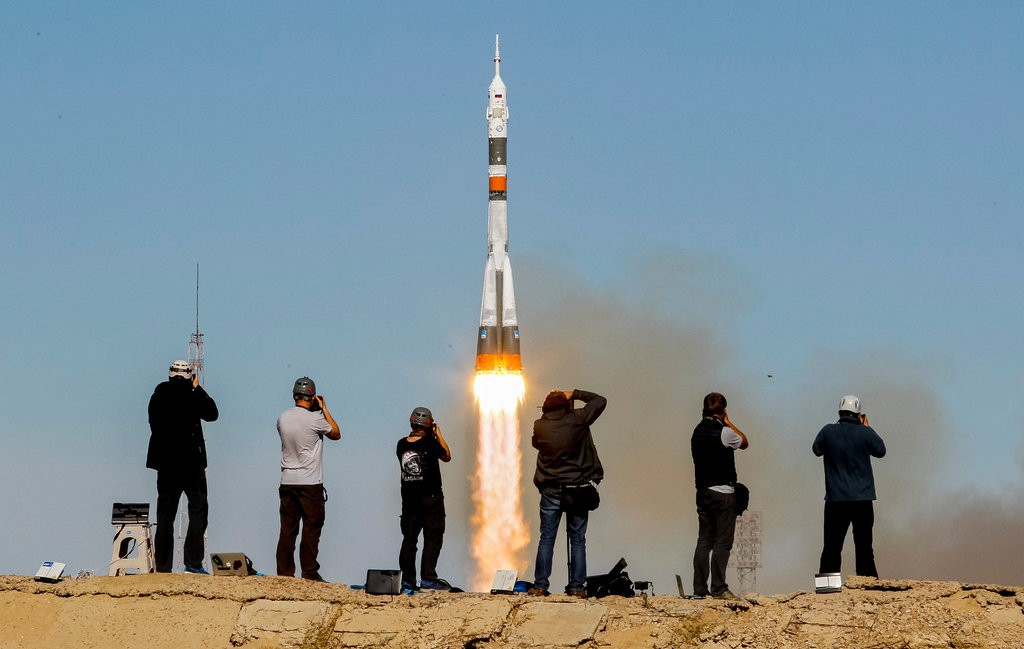
A malfunctioning Russian rocket led to an aborted mission and thankfully successful rescue for Russian and American astronauts headed to the International Space Station this morning:
More than 40 miles above Earth and hurtling toward space faster than a rifle bullet, a rocket carrying an American astronaut, a Russian cosmonaut and hundreds of tons of explosive fuel failed less than two minutes after liftoff on Thursday, forcing the crew to make a harrowing but safe emergency landing.
The capsule parachuted to Earth about 12 to 15 miles outside Zhezqazghan, a small city in central Kazakhstan, and neither of the crew members was injured, both the Russian and American space agencies said.
Russian state TV broadcast pictures of the capsule sitting in the middle of a flat, barren landscape dotted with low shrubs. The two astronauts — Nick Hague of the United States and Aleksei Ovchinin of Russia — walked to a rescue helicopter that whisked them back to the Baikonur Cosmodrome where their ill-fated voyage began.
Soon after, Roscosmos, the Russian space agency, tweeted a picture of the two men sitting and speaking with Dmitri O. Rogozin, the head of the Russian agency.
The first sign of trouble was reported publicly eight minutes after the liftoff of the Russian Soyuz rocket, when NASA tweeted, “There’s been an issue with the booster from today’s launch.”
Eleven minutes later, the agency added, “The crew is returning to Earth in a ballistic descent mode,” meaning that it was falling without propulsion and that its direction was determined only by the craft’s momentum, later braked by a parachute landing.
The agency added that ballistic descent means “a sharper angle of landing compared to normal,” which indicates a threat to the crew’s safety. The angle of the capsule’s descent is normally carefully calibrated so that it does not overheat when plunging back through the Earth’s atmosphere.
Forty-two minutes after liftoff, NASA tweeted that the Soyuz capsule had landed back on Earth. A search team was dispatched and soon, NASA added, rescuers reported that they were in contact with the Soyuz crew, who reported that they were “in good condition.”
A little more than an hour after launch, Mr. Rogozin said on Twitter that the crew had been rescued. “A state commission has been established to investigate the causes” of the failure, he added.
Dmitri S. Peskov, the Kremlin spokesman, told journalists in Moscow: “Thank God the cosmonauts are alive. This is the main thing.”
Jim Bridenstine, the NASA administrator, was present at the launch, which occurred at 4:40 a.m. Eastern Time.
Russia announced that it was suspending missions to the International Space Station until the cause of the failure had been determined. The current three-person crew on the space station would continue working until December, when the next launch was scheduled, the Russian news agency Interfax reported.
According to a Russian space official cited by Interfax, “the emergency occurred 119 seconds into the flight, during the separation of the side boosters of the first stage from the central booster of the second stage.” The second-stage booster rocket shut down.
Here are the Twitter updates that have been posted by NASA and the Russian space agency:
There's been an issue with the booster from today’s launch. Teams have been in contact with the crew. Updates: https://t.co/mzKW5uV4hS
— NASA (@NASA) October 11, 2018
The crew is returning to Earth in a ballistic descent mode. Teams are working to obtain additional information from our Russian partners. Watch live updates: https://t.co/mzKW5uDsTi pic.twitter.com/kWigYS1gU4
— NASA (@NASA) October 11, 2018
The Soyuz capsule has landed back on Earth carrying two crew members. Search and rescue teams are in contact with the crew and are en route to the landing location. Live updates: https://t.co/mzKW5uDsTi pic.twitter.com/G3IuAztH6O
— NASA (@NASA) October 11, 2018
https://twitter.com/JimBridenstine/status/1050337299542753280
#СоюзМС10: космонавт Роскосмоса Алексей Овчинин и астронавт @NASA Ник Хейг сейчас находятся в Жезказгане и проходят обследование перед вылетом.
Генеральный директор Роскосмоса Дмитрий Рогозин (@Rogozin) принял решение о транспортировке космонавтов на Байконур. pic.twitter.com/b1IzKZZI8O
— РОСКОСМОС (@roscosmos) October 11, 2018
Here’s the video of how things unfolded this morning; (h/t Jazz Shaw)
The Soyuz spacecraft that the Russians use to send Cosmonauts into orbit is essentially the same vehicle that they have used since the late 1970s and 1980s and which the United States has relied upon to get astronauts into orbit since the end of the Space Shuttle program several years ago. Despite its age, and the fact that returning to Earth means landing in the hard Earth rather than in the ocean or via Shuttle as Americans used to, the Soyuz has been a fairly reliable vehicle for getting people to and from the International Space Station. Indeed, there has not been a recorded accident involving a Soyuz craft since the early 1980s. Additionally, the Soyuz craft has proven to be both sturdy and reliable, something that can be seen in the fact that this one essentially was forced to return from the edge between Earth’s atmosphere and space after the failure became apparent.
Notwithstanding all of that, NASA has been working with SpaceX and other companies to develop an independent means of getting men to and from the ISS that doesn’t rely on Russian launch facilities and launch vehicles. That mission has taken on some new energy in recent years given the increase in tensions between the United States and Russia in the wake of the Russian occupation of Crimea and Russian military action in Syria. While those events don’t appear to have impacted the relationship between NASA and the Russian space agency, and the United States continues to pay Russia for the ability to use the Soyuz to send Americans into orbit, the possibility that this relationship could sour is certainly one reason why American experts are eager to get an alternative means to transportation going as soon as possible.
One thing that this reminds us of, of course, is that space travel, even in the form of a launch to the relatively nearby International Space Station, is still far from a routine matter. Every launch and every mission carries with it the risk of failure and tragedy, something we ourselves have seen several times since the Space Age began. In 1967, for example, three of America’s top astronauts died in a fire on the launch pad during a test for what would have been the first manned flight for the Apollo program. Three years later, a mid-mission disaster for Apollo 13 led to a touch-and-go effort to return home to Earth that was thankfully successful. And,of course, most notably there was the Challenger disaster in 1986 and the Columbia disaster in 2003, both of which resulted in the loss of both the spacecraft and all hands on board. Thankfully, things ended more happily today, but it’s not difficult to imagine how things could have turned out differently.
At least for the short term this incident will mean that no new crews will be heading to the ISS until a full review of what happened today can be completed. However, that shouldn’t impact the situation on the ISS too badly. Thanks to SpaceX and its resupply missions, we already have a means to get supplies to the station, and the company and several of its competitors continue to work toward the ability to send a crew to the ISS on SpaceX vehicles, something that could finally enter the final testing phase some time early next year. The quicker that happens, it would seem, the better.
Photo via Reuters

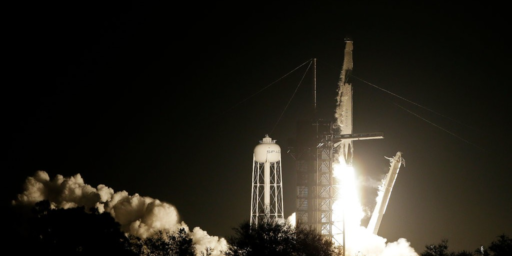
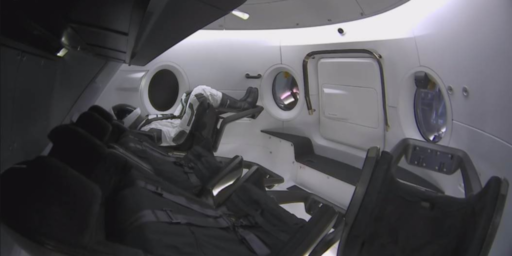
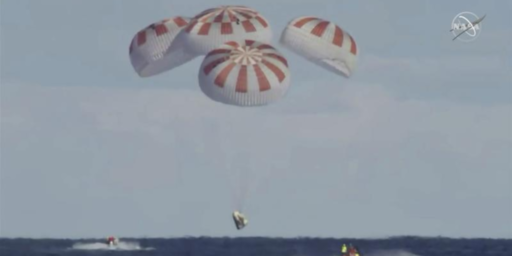
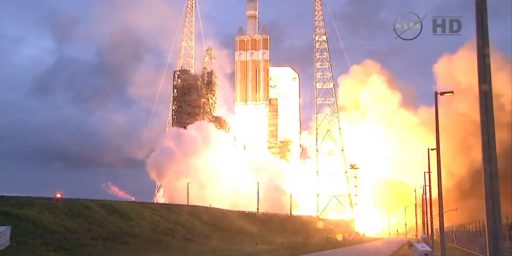
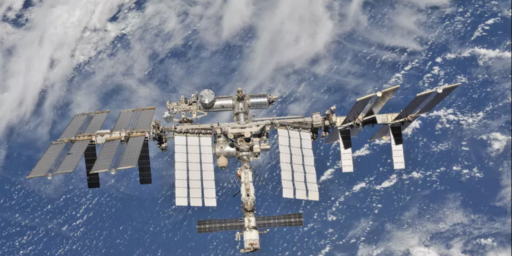
Fantastic that nobody was killed. But I gotta say, the first thing that occurred to me, half seriously, is whether it’s the work of the same saboteurs that drilled a hole in the space station.
Early information is so infuriatingly incomplete, and doubly so when out of the ordinary technology is involved.
If you look at the photo on top of the post, you’ll notice a slim white tower on top of the Soyuz capsule. That’s a small solid-fuel rocket which can pull the capsule away in the event of a failure with the booster.
Apollo used the same system. Though in Apollo the escape system was jettisoned alongside the first stage when the latter burned its fuel. At that altitude, the capsule could merely be ejected from the third stage of a Saturn V, or the second stage of a Saturn I-B, and drift down to safety. I don’t know if the Soyuz works on the same principle or not.
BTW. Mercury also used an escape rocket. Gemini relied on ejection seats. The Shuttle had no escape system at all. As I recall, the contemplated failure would be on the Shuttle’s own main engines (solid rockets aren’t supposed to be able to fail; but in Challenger they did so). and, if that happened, then either the boosters would finish burning or could be prematurely detached. Either way the Shuttle was supposed to glide back to some sort of landing.
After Challenger, ejection seats were adopted. but they wouldn’t have done any good in a similar accident. The Shuttle system of external tank and boosters was too complex for reliability. The wonder is that “only” two were lost.
BTW, what makes space travel so dangerous are the energies involved in it. The exact quantities vary, but a payload in low Earth orbit (LEO) requires a speed of around 5 miles per second to stay in orbit. That’s about 18,000 miles per hour. And that requires a lot of energy. That’s why you see enormous rockets with comparatively tiny payloads.
These speeds are far outside normal experience. In fact, it can be proved that no vehicle can achieve such speeds, and that is entirely true. That’s why rockets have stages. Essentially you get a rocket going as fast as it can, carrying another, smaller rocket as payload, which in turn has its own payload.
Worse, you have what’s known as the rocket equation. It can be stated thus: in order to carry a heavier payload, you need more fuel. Because that fuel has mass of its own, you need additional fuel in order to carry it.
What this means is the chemical energy stored in a rocket’s fuel tanks is enormous.
The fuels used are also highly flammable, and burning them results in very high temperatures to the engines and the escaping combustion gasses. Any leaks tend to blow up (see the Challenger disaster). And all that stored chemical energy letting go at once, causes a spectacular fireball.
And not only that. Rocket fuel is divided between propellant, the substance that burns, and an oxidizer, the substance that makes combustion possible. The most common for the latter is liquid oxygen, which has additional engineering issues of its own. But as far as safety goes, it means that the propellant has plenty of oxidizer nearby, so it can burn violently upon leaking.
Returning to Earth, the spacecraft has to shed the energy it has gained. This is relatively economical, because Earth has an atmosphere that provides air resistance and drag. So you need to shed only a little energy, then the atmosphere will absorb the rest.
But, remember, there are downsides to everything. Also, energy can’t be neither created nor destroyed, only transformed (ie, everything goes somewhere). In this case, the air in the atmosphere cannot move out of the way of the reentering spacecraft fast enough, therefore it gets compressed. When you compress a gas, its temperature rises (and it lowers when it expands, which makes refrigeration possible). This generates in effect a travelling fireball of super heated air that surrounds the craft making reentry.
To prevent killing the people inside, not to mention melting the spacecraft, you need a heat shield. Something that will a) resist the high temperatures and b) stir the super hot air around the craft. A breach in the shield is fatal, as happened to Columbia.
But there’s hope in progress. The next most energetic means of transportation is air travel, which also requires large amounts of fuel. Commercial air travel has become a very safe mode of travel, not to mention convenient, even if it’s not especially comfortable these days.
@Kathy: I used to be a big fan of replacing rockets with like a multi-mile EM track that would speed cargo containers up to like Mach 40 and then shoot them into orbit with no onboard machinery or fuel.
Then physics school happened and I realized the downfall of this idea is that it would work opposite to how rockets work in a fatal way: the container would be going its fastest at altitudes where the air is densest. 🙁
@Teve:
Imagine how Jules Verne’s astronauts would have fared, reaching far above escape velocity at sea level!
An EM track would work well on the Moon, and it would be cheap to power given two weeks of uninterrupted sunlight per month. It might work on Mars, due to the much thinner atmosphere.
It could be made to work on Earth, if it were sloped upwards to near orbital height. But then you’d be better off building a Space Elevator. We’ll need something like that, or some sort of revolutionary propulsion system like antigravity, in order to make space travel routine and affordable.
Kudos to Aleksei Ovchinin. As the Russian on that flight, he was the man in charge. He commanded. He made the decisions — and he kept himself and Nick Hague alive. He ought to get a medal for that — maybe not a Congressional Medal of Honor but something fairly significant. And it ought to be shown on television — Russian television — with a pretty high ranking American government figure pinning on the award. Mike Pence perhaps?
You want to make this world better, folks? Hand out some praise when it’s due, regardless of ideologies and politics. There’s nothing cheaper and nothing more valuable.
@Kathy: A rocket is nothing more than a controlled explosion.